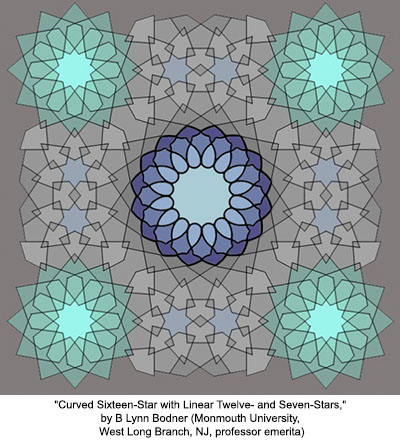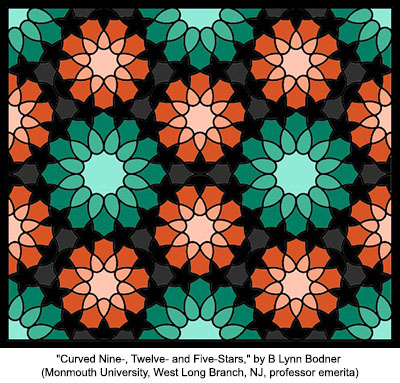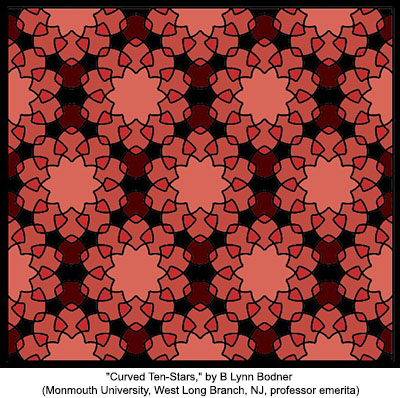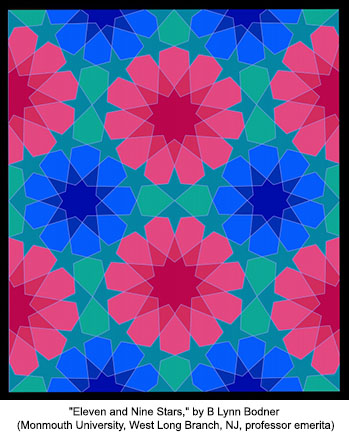
Mathematical ImageryMathematical artists create strong, stunning works in all media and explore the visualization of mathematics
Patterns in Islamic Ornamentation :: B Lynn Bodner
My primary interest involves the examination and analysis of the patterns and symmetry evident in geometric Islamic ornamentation found during various time periods and in different regions of the Islamic world. Using mathematical group theory, which provides a scientific means for classifying a geometric pattern according to the set of symmetries that exist in the design as a whole, I seek to ascertain which symmetry groups were preferred and intuitively recognized as being “right” by various Islamic cultures. Additionally, I enjoy the challenge of finding plausible Euclidean compass and straightedge constructions of these fascinating geometric patterns.
— B Lynn Bodner, Monmouth University, West Long Branch, NJ, professor emerita

Digital print, 2015. This Islamic pattern is a reconstruction of a similar one that may be found today as a carved wooden panel on a minbar (pulpit) of the Masjid (mosque of) al-Amir Qijmas al-Ishaqi in Cairo, Egypt (& also as Plate 135 in Bourgoin's "Arabic Geometrical Pattern and Design.") The original panel, created in 1481, is considered a Mamluk masterpiece. This image consists mainly of four regular 12-star & eight nearly-regular 7-star polygons surrounding a single curved regular 16-star. It was created using only a compass & straightedge following Euclidean construction techniques (which preclude measurement of any kind). For more information, see the artist's webpage for her paper entitled "Curved Islamic Star Patterns of Medieval Egypt and Syria."

Paper and ink computer-generated image, 20" x 20", 2013. This pattern was constructed using Euclidean techniques and the electronic equivalent of compass and straightedge. It was based on a square repeat unit known as Catalog Number 30 (CN30) of the Topkapi Scroll. CN30 has half 13-stars along both the right vertical and bottom edges, with a quarter of a 16-star centered on the upper left vertex of the square. To achieve this image, CN42 was replicated by reflection across its edges yielding a square of 16 colored copies of the repeat unit. This was then rotated 45 degrees and the half of the image outside a 2nd smaller square (formed by joining the midpoints of the 1st square) was erased. CN30 is the only 13-star pattern in the Topkapi Scroll, thus, it too was quite challenging to recreate.

Digital print, 2015. This Islamic pattern is a reconstruction of a similar one that may be found today on a bronze door of the Masjid al-Sultan al-Nasir Hasan in Cairo, Egypt. Created in 1363, it is considered a Mamluk masterpiece. It may also be found as Plate 121 in Bourgoin's 1879 book entitled "Arabic Geometrical Pattern and Designs." This image, consisting mainly of curved regular 12-star polygons and curved nearly-regular 5-star and 9-star polygons, was created using only a compass and straightedge following Euclidean construction techniques (which preclude measurement of any kind). See the artist's webpage for a paper entitled "Curved Islamic Star Patterns of Medieval Egypt and Syria" for more information on this pattern (and various other constructions).

Digital print, 2015. This Islamic pattern is a reconstruction of a similar one (Plate 181) illustrated in Jules Bourgoin's 1879 book, "Arabic Geometrical Pattern and Designs," which contains sketches of over 200 Islamic patterns found at the end of the 19th century on then extant historic monuments in Cairo and Damascus. This image, consisting almost entirely of curved regular 10-star polygons, was created using only a compass and straightedge following Euclidean construction techniques (which preclude measurement of any kind). See the artist's webpage for her paper entitled "Curved Islamic Star Patterns of Medieval Egypt and Syria" for more information on the construction of this pattern, as well as information on the constructions of various other patterns.

Paper and ink computer-generated image, 20" x 16", 2013. This pattern was created using Euclidean construction techniques and the electronic equivalent of the compass and straightedge. It was based on a rectangular repeat unit sketch known as Catalog Number 42 (CN42) of the Topkapi Scroll, which contains 114 Islamic architectural and ornamental designs dating from the 15th or 16th century. CN42 has half 11-stars along its vertical edges and half 9-stars along its horizontal edges. To achieve a complete pattern, this repeat unit must be replicated by reflection across its edges. The image displayed here contains four colored copies of the CN42 repeat unit. Since CN42 is the only sketch in the Topkapi Scroll containing 11-pointed star polygons, it was one of the more challenging ones to recreate.



